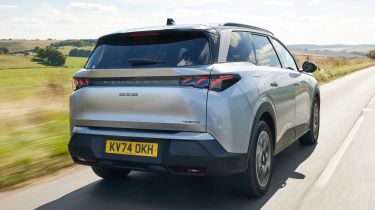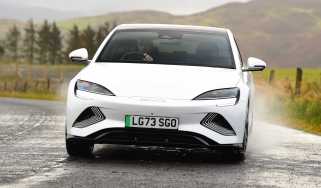Peugeot 5008 - MPG, emissions & running costs
The Peugeot 5008 has embraced electrification more fully than most other large SUVs

The latest evolution of the Peugeot 5008 offers buyers a choice of models to suit their lifestyle and driving habits. For instance, if it's the maximum convenience you’re after, the entry-level 5008 Hybrid doesn’t need to be plugged in for a charge. Instead, it recuperates energy when the car slows down to top up its 0.9kWh battery.
The small battery only allows the 5008 Hybrid to cover very short distances at low speeds on battery power alone, but that’s enough for it to return up to 52.5mpg, according to Peugeot. During our testing, we only managed to achieve 40.8mpg. And that was with just two adults on board.
Above this is the 5008 plug-in Hybrid, which, as its name suggests, needs charging whenever possible, because it features a much larger 21kWh battery. But the benefits are fuel efficiency up to 356.2mpg, Peugeot claims, and a pure-electric range of up to 48 miles. We’ve yet to test this particular version and its fuel economy claims for ourselves.
| Model | MPG | CO2 | Insurance group |
| 5008 Hybrid 136 e-DSC6 | 52.5mpg | 122-143g/km | 23E |
| 5008 Plug-in Hybrid | 356.2mpg | 18-30g/km | 35E |
Electric range, battery life and charge time
The Peugeot 5008 Plug-in Hybrid offers a pure-electric range of up to 48 miles thanks to its 21kWh battery, which should allow most people to commute to work or do the school run without using any petrol. The plug-in hybrid Skoda Kodiaq iV can cover 75 miles on battery power alone, but it is only available with five seats.
Used - available now
The 5008 Plug-in Hybrid has a maximum charging speed of 3.6kW, so fully recharging it will take around five-and-a-half hours from a typical 7kW home wallbox charger.
Finally, there’s the fully electric Peugeot E-5008, which we’ve done a separate in-depth review of if you’re interested in the EV version. It’s available with a 73kWh battery that offers up to 310 miles of range, and a larger 98kWh battery in the Long Range version with up to 415 miles of range on one charge. Both versions have a peak charging speed of 160kW and should manage a 20-80 per cent top up on a suitably rapid charger in around 30 minutes. Overnight charging from flat to full using a typical 7.4kW wallbox charger should take just under 12 hours in the 73kWh model, and 15.5 hours in the 97kWh version.
Rather disappointingly, a heat pump is an option with the E-5008. A heat pump is a more energy efficient way of heating the interior in colder weather, helping to maintain your overall range and benefit efficiency. It’s a worthwhile option for those who have to tackle a long commute because you shouldn’t lose too much of your range in winter compared with warmer summer weather.
| Model | Battery size | Range | Insurance group |
| E-5008 210 73kWh | 73kWh (useable) | 311 miles | 33E |
| E-5008 230 Long Range 97kWh | 96.9kWh (useable) | 414 miles | N/A |
Tax
The 5008 Hybrid falls into the 31 per cent Benefit-in-Kind (BiK) tax band, while the 5008 Plug-in Hybrid attracts an eight per cent BiK rate thanks to its EV range and CO2 emissions as low as 18g/km. Of course, company car drivers will be most interested in the pure-electric E-5008, which like all EVs, currently attracts a BiK rate of just two per cent.
But because all but the most basic 5008 has a list price of over £40,000, it requires paying the expensive car supplement, sometimes referred to as the luxury car tax. That means you’ll need to pay an additional fee above the standard annual Vehicle Excise Duty (VED) from the second time the vehicle is taxed until it is six years old.
Insurance
The Peugeot 5008 starts in insurance group 23 for the entry-level hybrid and goes up to 35 for the plug-in hybrid. Costs are likely to be lower than the Hyundai Santa Fe, which starts in group 33 and goes up to 36 for the plug-in hybrid. However, the Skoda Kodiaq should be more affordable to insure because it starts in group 18 for the entry-level mild-hybrid petrol, while the plug-in hybrid Kodiaq iV is in group 24.
Figures for the Long Range electric version haven’t been announced yet, but they shouldn’t differ all that much from the regular 73kWh version, which starts in group 33.
Depreciation
According to our expert data, the latest Peugeot 5008 is predicted to maintain between 48 to 49 per cent of its resale value after three years or 36,000 miles, with the top-spec GT trim in plug-in hybrid form hanging on to the most value. Meanwhile, the electric Peugeot E-5008 is predicted to retain more of its value than its hybrid or plug-in hybrid siblings, between 53-55 per cent.
For comparison, the Skoda Kodiaq should retain between 41 to 50 per cent of its value over the same period.
To get an accurate valuation of a specific model, check out our valuation tool...












